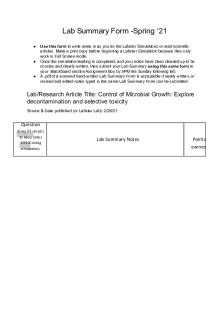Microbial Nutrition, Ecology, and Growth PDF

| Title | Microbial Nutrition, Ecology, and Growth |
|---|---|
| Author | Kamryn Stone |
| Course | Intro To Microbiology -S |
| Institution | University of Louisville |
| Pages | 3 |
| File Size | 84.2 KB |
| File Type | |
| Total Views | 158 |
Summary
This lecture was led by Paul Himes and covers the topics of Microbial Nutrition, Ecology, and Growth...
Description
Microbial Nutrition, Ecology, and Growth Lecture led by Paul Himes
Microbes Must Obtain Nutrients from Environment ● If we want to live/grow, we need: ○ Source of elements ■ For building macromolecules ■ Anabolic reactions ■ Some are essential nutrients ● Substances that must be provided to organism ● Can’t make them ● Need to get from diet ○ Need macronutrients and micronutrients (trace elements) ○ Acquired from reservoir in environment ○ Can be categorized according to C content ■ Inorganic nutrients vs Organic nutrients
Microbial Nutrition Strategies ● Carbon Source: ○ What do we call organisms that make their own organic molecules from CO2? ○ What do we call organisms that get organic carbon from their food? ● Energy Source: ○ What do we call organisms that get energy from sunlight? ○ What do we call organisms that get energy from eating chemicals? ● Every combination is possible and does exist ● Saprobes (Saprophytes) ○ Free living molecules ■ Not pathogens ○ Decomposers - get their C from eating dead things ■ Can degrade: Plant litter, Animal matter, Dead microbes ○ Chemoheterotrophs ○ Most have rigid cell wall (fungi/bacteria) ■ Can’t engulf food ■ Release enzymes → environment → digest food particles → smaller molecules then can be imported via pores in membrane ● Obligate Saprobes → exist strictly on dead organic matter in soil and water ○ Need to be free living, can’t infect host ○ Not as common as once thought ● More and more commonly, what we thought to be obligate saprobes are found to be facultative parasites/opportunistic pathogens
○ Don’t infect everything, but can infect susceptible hosts ■ Things with weakened or damaged immune responses ○ Host not primary habitat ■ Not saprobes first choice ■ If nothing stops it, will treat host like dead stuff to decay ● Parasites ○ Derive nutrients from cells or tissues of host ○ Differ from saprobes in that they get their C from other things that are still alive ○ Chemoheterotrophs ○ Not all parasites damage the host directly ■ May steal the host’s food ○ Pathogens → cause damage to tissues or even death as they take C and energy from host ● Types of parasites (location based) ○ Ectoparasites - live on the body ○ Endoparasites - live in the body (organs and tissues) ○ Intracellular Parasites - live within the cells ○ Obligate Parasites - unable to grow outside of a living host
Macronutrients - Hydrogen ● Major part of all organic and many inorganic compounds ● Performs overlapping roles in the biochemistry of cells: ○ Maintaining pH ○ Forming hydrogen bonds between molecules ○ E- transport during respiration/photosynthesis → H+ gradient → free energy for: ■ ATP synthesis ■ Flagella rotation
Macronutrients - Nitrogen ● Mainly found in: ○ DNA ○ RNA ○ Proteins ● Main reservoir - N2 (the atmosphere) ○ Used in cells as -NH3 ■ Only form that can be attracted to C ■ Primary nitrogen source for heterotrophs
Macronutrients - Oxygen ● Major component of organic compounds ● Also found in inorganic salts ○ Phosphates ○ Sulfates ○ Nitrates ○ H20 ● Terminal electron acceptor in aerobic respiration ○ Strongest oxidizing agent ● O2 makes up 20% of the atmosphere ● Not everything can use atmospheric O2 ○ Or even survive when it’s present
Macronutrients - Phosphorus ● Mainly used as Phosphate (PO43-) ○ Key component in nucleic acids ○ Also found in ATP ○ Regulate protein activity ○ Phospholipids in cell membranes and coenzymes
Macronutrients - Sulfur ● ● ● ● ●
Widely distributed throughout environment in mineral form Essential component of some vitamins (B1) Amino acids - methionine and cysteine Crucial for photosynthesis Coenzyme A ○ Connection between glycolysis and Krebs cycle ○ Part of fatty acid biosynthesis/degradation ● Energy donor for some anaerobes
Other Elements ● ● ● ● ● ●
Potassium (K) - Protein synthesis, membrane function, and help with transport Sodium (Na) - Cell transport, action potential Calcium (Ca) - Stabilizer Magnesium (Mg) - Found in chlorophyll and a cofactor in enzymes Iron (Fe) - Found in cytochrome and hemoglobin Zinc (Zn) - A regulatory element...
Similar Free PDFs

Microbial Growth & Nutrition
- 14 Pages

Ecology and Organisms
- 3 Pages

Microbial Control
- 3 Pages

Business Creation and Growth
- 29 Pages

Growth and Development Notes
- 10 Pages

Human growth and development
- 46 Pages

Growth and development chart
- 9 Pages
Popular Institutions
- Tinajero National High School - Annex
- Politeknik Caltex Riau
- Yokohama City University
- SGT University
- University of Al-Qadisiyah
- Divine Word College of Vigan
- Techniek College Rotterdam
- Universidade de Santiago
- Universiti Teknologi MARA Cawangan Johor Kampus Pasir Gudang
- Poltekkes Kemenkes Yogyakarta
- Baguio City National High School
- Colegio san marcos
- preparatoria uno
- Centro de Bachillerato Tecnológico Industrial y de Servicios No. 107
- Dalian Maritime University
- Quang Trung Secondary School
- Colegio Tecnológico en Informática
- Corporación Regional de Educación Superior
- Grupo CEDVA
- Dar Al Uloom University
- Centro de Estudios Preuniversitarios de la Universidad Nacional de Ingeniería
- 上智大学
- Aakash International School, Nuna Majara
- San Felipe Neri Catholic School
- Kang Chiao International School - New Taipei City
- Misamis Occidental National High School
- Institución Educativa Escuela Normal Juan Ladrilleros
- Kolehiyo ng Pantukan
- Batanes State College
- Instituto Continental
- Sekolah Menengah Kejuruan Kesehatan Kaltara (Tarakan)
- Colegio de La Inmaculada Concepcion - Cebu








